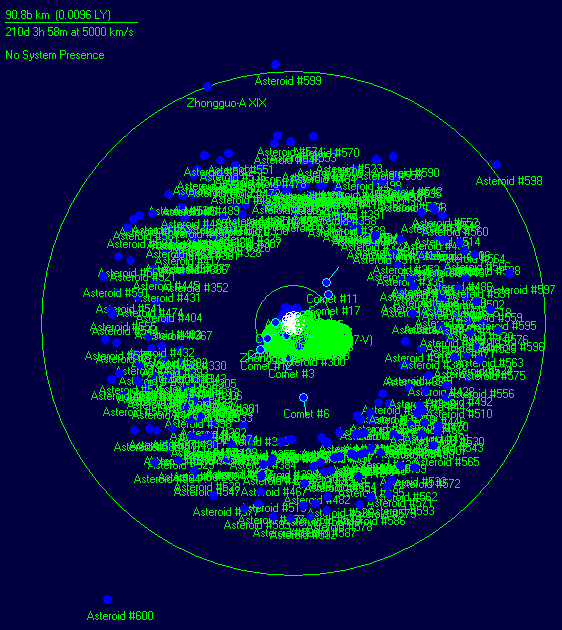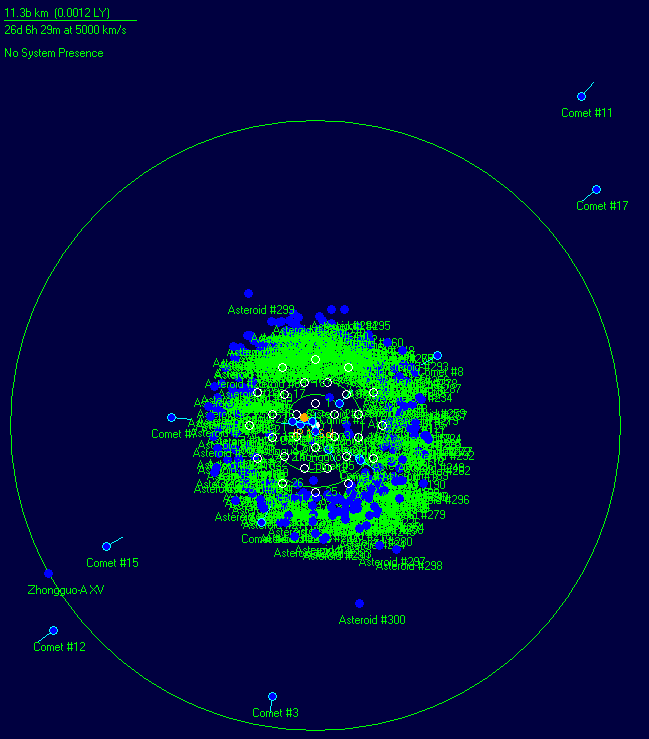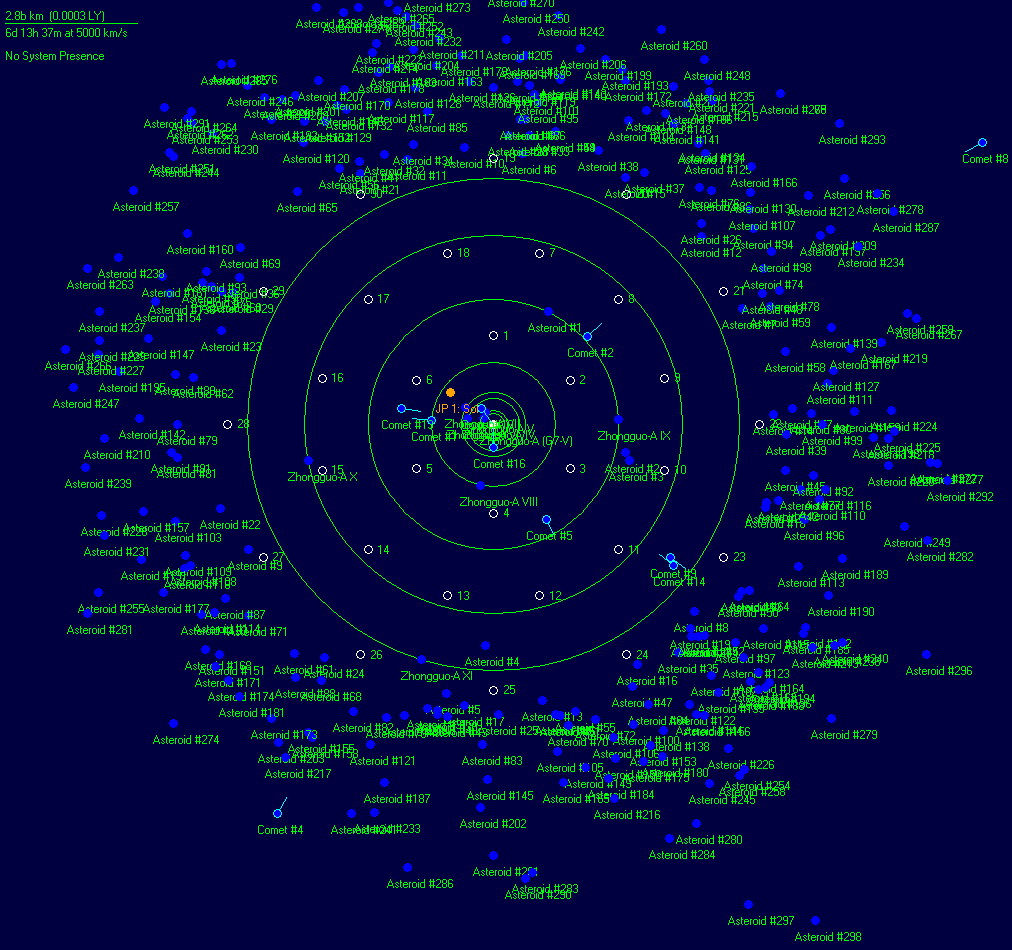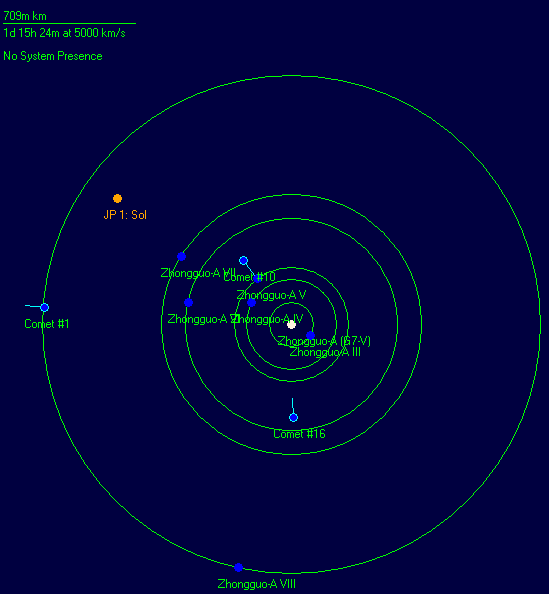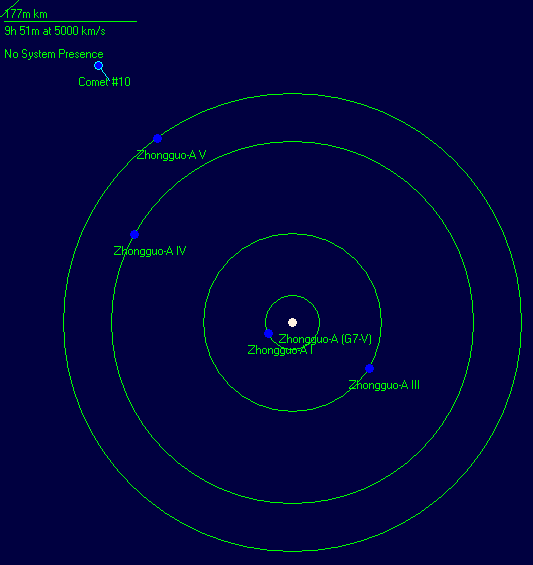Zhongguo
| This article is a stub. You can help the wiki by expanding it. |
Right Ascension: 5h 14m 38.39s
Declination: 44° 32' 59.99""
Distance: 7.05 parsecs (23 light years)
Zhongguo, informally NewChina or JP2, is a solar system claimed by the Eurasian Federation, linked to Sol by an ungated jump point near the orbit of Saturn.
In late November 2035, a UN espionage team on Mars discovered the astrographic charts for Zhongguo revealing it to have several colonizable planets, highly suited to human life.

Geography
Zhongguo is a star system 7.05 pc (23 light years) away at RA 5h 14m 38s, Dec -45.44°. To be determined at a later date. The sole star is a G7-V main sequence star, somewhat less massive than and only half as luminous as Sol. However, the system contains abundant bodies both major and minor.
The system can be divided into several main regions.
- The Inner System is a region roughly the size of our own solar system out to Pluto, containing ten planets, whose orbital distances vary from 36m km up to 5.2b km. The jump point to Sol is located in the Inner System at a distance of 1.15b km, bearing 306°.
- The innermost planet, Zhongguo-A I, is a Venus-like world about the size of Earth. With a pressure of over 90 atmospheres, and a surface temperature of nearly 750°C, it is an inhospitable place. It is significantly denser than Earth, leaving it with a much higher surface gravity.
- The next planet, Zhongguo-A III, is the third known planet (after Earth and Roanoke-B III, "Jamestown") with an nitrogen/oxygen atmosphere. Unlike Roanoke-B III, Zhongguo-A III's atmosphere is not thick enough to be breathable by humans without an oxygen concentrator unit. Zhongguo-A III is about 60% the diameter of Earth, and only about 16% the mass, leaving it with a surface gravity of about 0.42g. The planet is 31% covered by a thick sheet of water ice, has a day 39 standard hours long, and revolves around Zhongguo once every 274 Earth days. The low albedo of the planet drives its surface temperature down somewhat. Zhongguo-A III has one small moon, 156,000 km from the planet and 140 km in diameter.
- Zhongguo A-IV is another super-Earth, though without the runaway greenhouse effect of Zhongguo-A I. It has a nitrogen/carbon Dioxide atmosphere and a thick water/carbon dioxide ice sheet covering nearly three-quarters of the planet. The planet is somewhat less dense than Earth, so despite its large mass, its surface gravity is only 30% higher than Earth's. It has a surprisingly quick 14 hour rotation period and a revolution period about Zhongguo of 2.17 years. Its 11° axial tilt means that its seasons are rather less distinct than those on Earth. The large amount of carbon dioxide in the atmosphere lends added insulation to the planet, meaning that, despite being more than twice as far from Zhongguo as A III, it is nearly 10°C warmer. Zhongguo-A IV also has one small moon, 220,000 km out and 140 km in diameter. Rarely for a terrestrial planet, Zhongguo-A IV has an extensive ring system.
- Zhongguo-A V is an Earth-sized world with a mass less than half of Earth (giving it a surface gravity of about half of Earth's as well). It also has a nitrogen/oxygen atmosphere (somewhat easier to breathe than Zhongguo-A III, as there is about three times as much oxygen), but its distance from Zhongguo renders it far colder than either of the other two Earth-like worlds. It has a day 26 hours long and revolves around Zhongguo once every 3.1 years. It has small polar ice caps covering 10% of the planet's surface area. Zhongguo-A V has a single large moon, 1200 km in diameter, orbiting 47,000 km from the planet.
- Zhongguo-A VI is a small, atmosphereless world about half the size Ganymede. With a temperature of -186.2°C, it's surface gravity is too low to admit long-term human settlement.
- Zhongguo-A VII and VIII are giant planets with extensive moon systems (16 major moons for Zhongguo-A VII (ice giant about the size of Neptune) and 24 major moons for Zhongguo A-VIII (gas giant about the size of Saturn)). Several of these moons have surface gravities high enough to support human habitation, though most have no atmosphere and all have frigid temperatures between -175°C and -225°C.
- Zhongguo-A VII - Moon 1, diameter 3800, orbital distance 114,000 km, surface gravity 0.18g
- Zhongguo-A VII - Moon 2, diameter 3200, orbital distance 143,000 km, surface gravity 0.14g
- Zhongguo-A VII - Moon 4, diameter 3000, orbital distance 200,000 km, surface gravity 0.14g
- Zhongguo-A VIII - Moon 2, diameter 5200, orbital distance 150,000 km, surface gravity 0.2 g
- Zhongguo-A VIII - Moon 3, diameter 5800, orbital distance 200,000 km, surface gravity 0.27 g
- Zhongguo-A VIII - Moon 7, diameter 5000, orbital distance 400,000 km, surface gravity 0.24 g
- Zhongguo-A VIII - Moon 8, diameter 4200, orbital distance 450,000 km, surface gravity 0.20 g
- Zhongguo-A VIII - Moon 14, diameter 4200, orbital distance 800,000 km, surface gravity 0.18 g
- Zhongguo-A VIII - Moon 22, diameter 7600, orbital distance 11,600,000 km, surface gravity 0.21 g
- Zhongguo-A VIII Moons 3 and 22 are interesting in that they do possess atmospheres, though they are tenuous. Moon 3 has an atmosphere composed of nitrogen and trace amounts of methane. Most of the methane is frozen out on the surface of the body, and the total pressure is only 6% of sea-level on Earth. Moon 22's atmosphere is even more tenuous, at only 0.22% of sea-level on Earth. Orbiting more than 11 million km from Zhongguo-A VIII, this Mars-sized ice ball is not subjected to the tidal heating of its parent ice giant, and the entirety of its nitrogen/carbon dioxide atmosphere has frozen out onto the surface.
- Zhongguo-A IX is a rocky body with a frozen nitrogen/methane atmosphere 0.9% as thick as sea-level Earth. It is about 25% larger in diameter than Earth, but its icy composition gives it much less mass, resulting in a surface gravity only 43% of Earth's. It has a single moon 2000 km in diameter orbiting at 312,000 km. Interestingly, it shares an orbit with a trojan asteroid 60° behind it. There are also two other sizable asteroids between the orbit of Zhongguo-A IX and the next planet, one of which is nearly 400 km across.
- Zhongguo-A X is a Saturn-sized gas giant with 22 major moons, one of which, Moon 2 (diameter 2800 km, orbital distance 123,000 km) has enough surface gravity to support human habitation. However, its surface temperature of -231.4°C likely precludes it as a target for major colonization.
- About halfway between the respective orbits of Zhongguo-A X and A XI is a single small asteroid.
- Zhongguo-A XI is a huge gas giant, 10% larger in diameter than Jupiter and more than 7.5 times more massive. Like the other giant planets of the Zhongguo system, it has an extensive moon system, with more than 30 bodies cataloged. Two of them (Moon 15: diameter 4800 km, orbital distance 1.46m km, surface gravity 0.23 g; Moon 24: diameter 3800, orbital distance 6.9m km, surface gravity 0.15 g) have sufficient surface gravity to support human habitation. Like the other "habitable" outer moons, it is likely far too cold to ever be a serious colony.
- The Middle System contains an expansive ice asteroid belt (as opposed to the metallic/rocky asteroid belt of Sol) and a minor planet.
- Between Zhongguo-A XI and Zhongguo-A XV is a massive asteroid belt, containing over 300 asteroids with orbital distances between 5.8b km and 15.6b km, though most are within a 10b km radius of Zhongguo.
- Zhongguo-A XV is a small, airless, icy body, 1000 km in diameter. It is likely that it is the largest remnant of the event that caused the scattering of the asteroids within the Middle System. The large gap between the Middle and Outer asteroid belt is largely due to the gravitational influence of Zhongguo-A XV.
- The Outer System contains another large field of minor bodies (likely icy in nature, similar to the Middle System Belt) and a final, distant gas giant.
- The Outer System Belt is composed of nearly 300 asteroids, ranging in orbital distance from 71b km to 177 b km. There is also a single outlier nearly 230b km out. It is likely this body is in the process of being ejected from the Zhongguo system by a gravitational interaction with Zhongguo-A XIX. There are also several large voids in the belt where no asteroids are present.
- Zhongguo-A XIX is another Uranus-sized ice giant with 25 known moons. Five have sufficient surface gravity for long-term habitation. However, all are airless and have surface temperatures approaching absolute zero.
- Moon 1, diameter 3000 km, orbital distance 84,000 km, surface gravity 0.13 gs
- Moon 4, diameter 3000 km, orbital distance 167,000 km, surface gravity 0.11 gs
- Moon 10, diameter 13,950 km, orbital distance 363,000 km, surface gravity 0.55 gs
- Moon 15, diameter 2200, orbital distance 781,000 km, surface gravity 0.10 gs
- Moon 24, diameter 3000, orbital distance 7,600,000 km, surface gravity 0.12 gs
The system also contains 17 known active comets, ranging in size between 24 and 200 km and with aphelions between 708m and 82b km.
System Schematics
An overview of the Zhongguo system. The outermost planet, Zhongguo-A XIX (top left), is more than 172b km from the system primary (1149 AU, or about 2% of a light year). The large outer asteroid belt is clearly evident, as is the significant gap between the inside edge of the outer belt and the "sentinel" planetoid, Zhongguo-A XV. Three comets can be seen in the gap. Also note the asteroid (labeled #600, bottom left) that is in the process of exiting the star system.
Zoomed from above. The orbit of the Zhongguo-A XV can be seen, as well as the gap separating it from the middle system asteroid belt. Here, the density of comets in the system becomes apparent.
Zoomed from above. Here the density of the middle belt can be appreciated. It should be noted that the inner edge of this belt is at a distance roughly corresponding to the average orbital distance of Pluto. Thus, these bodies have much more in common with Sol's Kuiper Belt Objects than with Sol's Mars-Jupiter asteroids. A number of Inner System comets can be seen.
Detail of the innermost planets. The orbital distance of Zhongguo-A VIII is approximately the same as Saturn's orbital distance from the sun. Zhongguo-A VII orbits at a distance comparable to that of Jupiter. The jump point to Sol lies between the two orbits.
Further detail of the innermost planets. This image contains the two most likely targets of Federation colonization efforts, Zhongguo-A III and Zhongguo-A IV.
